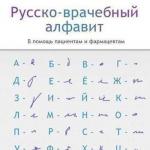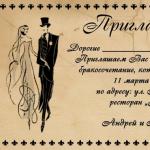French perfume from the 80s. Foreign perfumery of the Soviet Union
How many of you remember the smell of the Red Moscow perfume? If you were in the USSR era, then you must have heard this smell at least once, because it was one of the most popular and famous perfumes of that time.
In this issue we will remember what other examples of old-school perfumery were used by people of the Soviet era. To some, these names will mean nothing, but for others, they were and remain the scents of yesteryear, which cannot be replaced by any modern scent from Dior or Chanel.

1. Cologne “Carpathians”. Lviv perfume factory. Strong, noble-Soviet smell.

2. “Perhaps...” perfume. Or maybe not perfume? Created in Poland and named after Eddie Rosner's popular song "Maybe". A floral bouquet with a delicate and airy aroma.

3. The legend of Russian perfumery - “Red Moscow” perfume. For some, these perfumes are a symbol of the era and longing for the old days; for others, they are a sign of conservatism. The trail of perfume blooms with aromas of iris and vanilla.



6. Perfume “Kuznetsky Most”. The charm of a classic! Top note: grapefruit, currant. Heart of the aroma: pineapple. Base: cedar, musk.

7. Perfume “Recognition” was created at the Novaya Zarya factory and is dedicated to the theater. In easy flower arrangement there is a declaration of love for the theater and the woman. Citrus and fresh greenery with hints of white peony and jasmine are a hymn to beauty and emotions.

8. Perfume in the form of a table lamp is called “Lamp”. Plant "Flora", Tallinn.

9. Perfume “Darling”. Factory "New Dawn". Notes of freesia and incense.

10. Perfume “Charming Minx”. Factory "New Dawn". Tree moss, vanilla, coumarin.

11. Perfume “Persian lilac”. Factory "New Dawn". The noble aroma of lush lilac flowers.

Perfume and glass factory "Scarlet Sails". Quite a rich smell, in terms of impact it can only compete with Castaneda’s mushrooms. Enlightenment guaranteed.

13. Perfume “Lights of the Lighthouse”. Perfume and glass factory "Scarlet Sails". The perfume is light, watery and airy.

14. Chypre cologne. Created by the famous French perfumer Francois Coty. Having visited Cyprus, Coty decided to preserve the aromas of the island in his memory by creating the legendary cologne Chypre, or, in Russian, “Chypre”. The Soviet version of the cologne was significantly different from Coty's perfumery, but still had a strong and lasting aroma with notes of bergamot, sandalwood and oakmoss.

15. Vintage perfume “Queen of Spades” was made by perfumers of the “New Zarya” factory in honor of the 150th anniversary of A.S. Pushkin. A classic chypre scent with rich, juicy tones of oakmoss, patchouli and bergamot.

16. Perfume “Red Poppy”. Factory "Red Dawn".

20. The “Stranger” perfume belonged to the luxury class and cost approximately french perfume small volume, so they stood on store shelves for a long time and were considered a “status” gift.
Do you remember the scents of perfumes originally from the Soviet era? Maybe someone even still has bottles of perfume made in the USSR?
Today, everything Soviet is often criticized, and there is a lot of reason for this, because it’s true that life in the USSR was not easy, associated with many trials. Making basic purchases was not as easy as it is now. Even chocolates, coffee or bananas were not as easy to obtain as they are today. What then can we say about clothes, handbags and perfumes!
Buying French perfume was literally a holiday for Soviet women. For us today this sounds strange, since you can go into a perfume store and buy whatever your heart desires. And no need to say that perfumes are still expensive today. It's not like that at all; today it's very accessible. A bottle of Guerlain fragrance can be bought for some 2-3 thousand rubles, which is an insignificant part of the average salary. And in the USSR, the cost of French perfumes could be a third of the average salary, and they were not sold in public stores, so when buying perfumes, Soviet women also had little choice.
Just imagine a modern store with only 4-5 types of perfumes! Life was so harsh in the USSR. True, today we will not scold the Soviet Union, so much has been said about this, everything that was Soviet has already been mixed with dirt and this is also not good. Whether life was bad or good in the USSR, this is part of our history, in which there was bad, but there was also good, there was a place for feat, selfless work and heroism.


Today we will remember Soviet perfumes that were made in the USSR. Not French perfumes, but the aromas of our factories. In the USSR, these fragrances were more affordable than French perfumes, and today original Soviet perfumes are more expensive than the average French perfume.
Why does this happen? There are several reasons: firstly, it is not so easy to purchase original perfume from the times of the USSR, it is somewhat rare, and secondly, Soviet perfumery was made from higher quality components than today's fragrances. For the manufacture of Soviet perfumes and colognes they were often used natural ingredients, and production was regulated by GOST requirements, therefore the perfumes turned out to be of high quality.

Many bottles of Soviet perfumes, released 30-40 years ago, still preserve the aromas of the past to this day. Such perfumes can be purchased at various online auctions and in specialized stores. And for perfume connoisseurs, these fragrances become collector's items. In some collections, the amount of vintage perfumes - Soviet, French... is measured in hundreds of bottles!

What about current fragrances, modern perfumery?
Now, in pursuit of profit, perfume companies are trying in every way to reduce the cost of production, saving on everything possible - on the bottle, on the box and on the aroma itself.






Little is known about Soviet perfumery during the period after the revolution and World War II. In 1917, the world famous house of A. Rallet & Co was nationalized and first renamed State Soap Factory No. 4, and then became the Liberty Factory.
Content:
At the same time, the Novaya Zarya factory (the successor of the Brokar company) took up the production of fragrances, and Svoboda concentrated on the production of soap, tooth powders, creams, shaving products, etc. Unfortunately, the traditions and experience accumulated before the revolution were partially lost. And because of the political regime, there was no talk of free circulation of spirits between the USSR and Western countries.
In the Soviet Union, the following were extremely popular:
- “Riga lilac” from Dzintars;
- Anais Anais by Cacharel;
- Estee by Estee Lauder;
- Mon Parfum from Paloma Picasso and other legends, which we will talk about in more detail in this publication.
Industrial development in the post-war period
After World War II, the perfume and cosmetics industry was restored not only in the Soviet Union, but also in Europe. Already in 1947, Dior released the Miss Dior perfume, and a year later the house of Nina Ricci presented its fragrance L "Air du Temps. Production also resumed in the USSR essential oils and aromatic substances. The factories “New Dawn” and “Northern Lights” started working again. And in 1949, the training of future professionals began. But, despite the general increase in production and a wide range of (large and small factories produced up to 400 items!), the lack of variety of raw materials gradually became noticeable. To exchange experience, leading specialists and employees of Soyuzparfymerprom and VNIISNDV began to travel abroad already in the 1950s and 60s - to China, France, Switzerland, then business trips took place to Brazil, the USA and Holland. There they got acquainted with Western craftsmen and the work of perfume companies.
However, the exchange of experience was not one-sided. Then, for the first time in the USSR, a show took place fashionable clothes house of Dior. This happened in 1959, and at the same time Soviet women discovered the Miss Dior scent. They say that representatives of the French fashion house brought with them about 500 liters of perfume. Some of them were sprayed during fashion presentations, and some were presented to the wives of diplomats and senior officials.
Despite the fact that “New Dawn”, “Northern Lights” and other factories of the Union republics produced their products in sufficient quantities, good cosmetics and perfume remained in short supply. At the same time, by good they often meant imported goods. Sometimes perfumes from European countries, primarily East Germany, Poland, and France, appeared in the USSR, but they were distributed through narrow channels of personal connections or sold in the Beryozka stores that appeared in the mid-1960s.

The most accessible imported perfumes were, perhaps, Polish ones, for example, Pani Walewska, combining aldehydic notes with tones of rose, jasmine and lily of the valley. Or the Bulgarian Signature, Sonnet, Capri, Sha Noar and others. But, of course, the French ones were considered the most desirable. The bottles were stored for decades, even long empty. Let's remember some of them.
One of the most popular fragrances among Soviet women is Fidji. A light, feminine, airy composition of notes of iris, hyacinth, jasmine, violet and rose with the addition of citrus accents and warm woody musk tones was released by Guy Laroche in 1966. The dream of millions of women was perfect for both daytime use and creating evening look. Many are still on the hunt for Fidji, but today this Pacific Islands-inspired eau de toilette is produced under license by L'Oreal.
Climat from the French brand Lancome is a whole era and, in some way, a symbol of the 1970s. Being the embodiment of femininity, luxury and charm, this composition has become one of the most desired gifts Soviet woman. Just remember “The Irony of Fate”, where Ippolit Matveevich gives Nadya a bottle of French perfume. This black and white box contained exactly the Climat! The film shows the original 1967 design. Only later did packaging become familiar to us of blue color. The original composition, created by Gerard Goupy, was built on unforgettable floral-aldehyde chords. Unfortunately, today Climat in its original form is no longer produced. In 2005, Lancome, celebrating its 70th anniversary, brought back some fragrances to life, including Climat. The brand's perfumers tried to recreate the bouquet as closely as possible, but the charm of the original was too difficult to replicate. The bottle, created in the 1960s by artist Georges Delhomme, has also undergone changes.

Another legendary creation by Gerard Goupy - the attractive, mesmerizing, bottomless Magie Noir. More than one woman in the USSR in the 1980s lost her head after hearing the symphony of this magical perfume. A complex composition of notes of black currant, raspberry, hyacinth, Bulgarian rose, honey, jasmine, tuberose, lily of the valley, narcissus, cedar chords, musk, sandalwood, vetiver and other undertones, it would seem worthy of being the creation of the times of medieval alchemists. But it was then that witches and witches were burned at the stake! Truly, this bouquet is luxurious, as is its black glass bottle, designed by Pierre Dinant.
A real masterpiece and standard of oriental perfumes. At the same time scandalous and seductive, provocative and bewitching, Opium, released by the house of Yves Saint Laurent in 1977, was, according to some, a hidden drug propaganda! According to Yves-Saint Laurent himself, perfumers Jean-Louis Sieuzac and Jean Amic were supposed to create perfumes worthy of the Chinese Empress Ci Xi herself. The complex, multi-layered interweaving of citrus notes with sensual, spicy chords, animalistic, balsamic and smoky woody tones is ingenious and unique!

Aroma Yves Saint Laurent
- Opium
Other iconic compositions
By the way, oriental perfumery was held in special esteem in the 1970s and 80s not only in the USSR. But in the Soviet Union, among similar fragrances, perfumes such as those from Christian Dior, the Guy Laroche brand, Ispahan from Yves Rocher,
However, it should be said that in the Soviet Union there were fragrances that became popular in the West. One of the striking examples is, released in 1992 under the brand of Soviet fashion designer Vyacheslav Zaitsev. True, this perfume was developed jointly with L’Oreal, but the designer participated in its creation from start to finish and came up with the name himself.
Maroussia is the name of the mother and granddaughter of Vyacheslav Zaitsev, and it is consonant with the phrase “my Rus'” (ma Russie, French). The aroma triumphantly appeared on the Western market and arouses interest to this day. Including in modern Russia. Its intriguing sound intertwines invisible fibers of a whole galaxy of shades, among which animalistic, aldehydic, floral, resinous and sweetish facets stand out.
What perfumes do you remember from the Soviet past?
"Blue fog. Snow expanse,
Subtle lemon moonlight.
The heart is pleased with quiet pain
Something to remember from my early years.” S. Yesenin.
From time to time, each of us mentally returns to the past, remembering old times. For many this happens under New Year. But today we will not indulge in nostalgia, philosophize, be sad and yearn. Today we will indulge in the most pleasant memories, which will evoke the warmest feelings in most of us.
We will remember what perfumes our mothers and grandmothers used. What perfumes did women in the USSR love? Militta's readers, who are 30+, remember the scents that stood on the dressing table of their mother or grandmother.
Basically, many women of the 60s and 70s still had fragrances from our domestic manufacturers on their dressing tables. Perfume such as “Red Moscow”, “White Lilac”, “Silver Lily of the Valley”. Gradually they became a legend in Soviet perfumery, and for a long time enjoyed success among women. And once upon a time their appearance became a whole event in Soviet life.
Perfume “Red Moscow” were appreciated in Europe in 1958, 33 years after their release. Then they received the Grand Prix in Brussels. “Red Moscow” is the calling card of Soviet perfumery, real chic, and a fragrance with history.
Perfume "White lilac" appeared in 1947. Everyone still remembered the tragic events of the last war. And suddenly - this smell, as if the smell of spring, freshness, soaring over a devastated country, like the triumph of victory. But the White Lilac perfume remained unknown in Europe.

Perfume “Silver Lily of the Valley” They also became classics of Soviet perfumery, and one of the most sought-after fragrances of that era. In the 50s, to some extent, thanks to Dior, femininity became an ideal, and “Silver Lily of the Valley” personified this style. These perfumes have become business card Leningrad perfume factory "Northern Lights".
The smell of lilies of the valley was wafted about a year and a half apart - first in the USSR, and then in France. The aroma of modest forest flowers is a combination of many aromatic substances. “Lily of the valley silver” appeared in the USSR in 1954, and in 1956 the smell of lilies of the valley was heard in France from Dior. It was "Diorissimo". Josef Stefan Jellinek wrote about them: “Lilies of the valley smell like that only in heaven.” “Diorissimo” appeared in the USSR only in the 70s.
For Soviet women, imported perfumes were the stuff of dreams. For the most part these were spirits from “fraternal” socialist countries. But there were very few of these scents; most often they were perfumes from Poland and Bulgaria. And it was a pleasure to buy them. Because our perfumes “White Lilac”, “Silver Lily of the Valley” and many others that appeared in the very best quality, gradually simplified due to changes in composition. And this was done to increase production output (the five-year plan had to be fulfilled, and better yet, ahead of schedule).

The most popular in the 70s were the Polish perfumes “Pani Walewska” and “Perhaps”.
Perfume "Pani Walewska" were released in the 70s in Krakow. Maria Walewska is the Polish lover of the French Emperor Napoleon Bonaparte. Maria’s appearance is described by contemporaries as follows: “Charming, she showed the type of beauty from the paintings of Greuze. She had wonderful eyes, mouth, teeth. Her smile was so fresh, her gaze so soft,..."
Perfume "Pani Walewska" became incredibly popular in the 70s and 80s. Therefore, for many women of that time they remained a memory of youth and luxury. The composition of the fragrance included jasmine, lilies of the valley and rose, surrounded by a rich trail. Today, “Pani Walevska” perfume can be purchased; it is still produced, and in three versions. One of them is called Pani Walewska Classic.

Perfume "Maybe". Eddie Rosner was considered the best jazz trumpeter in Europe. During World War II, a Polish Jew ended up in Belarus, where he gathered refugee musicians and organized Bialystok jazz, which later became the State Jazz of the BSSR. The first concerts - and immediate success.
When jazz appeared in Moscow, there was a stir at the ticket offices. The comedy "Carnival Night" was voiced by musicians of the Rosner Orchestra. The Soviet pop orchestra conducted by Eddie Rosner performed in Krakow in 1955. Its soloist was the aspiring singer K. Lazarenko, she performed a song called “Maybe,” which Rosner wrote for her.

The Poles liked the song so much that after a while they released a perfume with the same name. And the perfume, in turn, became the favorite Polish scent in Russia. The composition is floral-chypre. Today these perfumes are produced by the Miraculum perfume factory, but the aroma is still different from its predecessor.
"Signature" Bulgaria
“Signature” is produced by the Bulgarian factory “Alen Mak” (Scarlet Poppy). These perfumes have also won the hearts of perfume fans, just like Polish scents. The smell reflected the era; elegance and sophistication were now in fashion. The composition contains Bulgarian rose, accompanied by aromas of tulip and mandarin, with a luxurious trail of iris.

Climate Lancome
In addition to the Diorissimo scent, Soviet women were able to smell another French masterpiece - Climat from Lancome. These perfumes were released in 1967, and in the USSR they could only be purchased in the late 70s, and even then not for everyone. They cost serious money at that time, and were also in short supply. And still, there were many women who bought the amazing scent.
The deep and delicate aroma of the perfume, the composition of which included violet, peach, lily of the valley, jasmine, aldehydes, rosemary, sandalwood, tonka bean, seemed worthy of this cost and was purchased when possible. Climate was the scent of luxury. Today it can be purchased in a vintage version, and its price still remains high. As we see, you have to pay for memories.

Undoubtedly, perfumes produced in the USSR also enjoyed success.
Perfume "Elena"
The Elena perfume from the Novaya Zarya factory was extremely popular among Soviet women in the 80s. The mysterious composition was released in 1978. Perfume belongs to the fruity-floral group. They feel lightness and freshness, romance and mystery. A woman with this fragrance should have uniqueness, elegance and perfection. She should also be a sweet, gentle and sensitive person.
These perfumes are suitable for women of any age - both mature and serious ladies and young, gentle creatures. The sophisticated composition captivates everyone. It contains black currant leaves and berries, lily of the valley, rose and jasmine, Virginia cedar, musk, tobacco leaf, sandalwood and amber. Today you can buy vintage perfume "Elena" from the "" factory.

Perfume "Tete-a-tete"
These perfumes were released in 1978 by the Novaya Zarya perfume factory together with French perfumers. They enjoyed the special favor of Soviet women. Perfume is more suitable for fantasy, eastern group aromas.
The initial release of “Tete-a-Tete” can be described as gentle, soft, they evoke dreaminess. They intertwine fresh notes of greenery and tangerine with the rich aroma of ylang-ylang and jasmine. Shades of rose add tenderness and charm. The scent trail is vetiver, patchouli, musk, amber, moss and sweet vanilla. Vintage perfume “Tete-a-tete” - for dreamy and sensual women.
One cannot forget the fragrances loved by Soviet women from the Latvian perfume factory Dzintars. For example, “The Secret of the Riga Woman”, “Compliment”, “Caprice”, “Coquette” and many others. These perfumes awed women almost as much as French perfumes. And, as they said then, it was easier to get (not to buy, but to get) them than French perfumes, and their cost was lower, although considerable.

Fragrance “The Secret of the Riga Woman”
The main components are rose and violet against a background of lily of the valley, jasmine, iris, magnolia flowers with a rich trail of musk and sandalwood. The perfume was released in 1987 and continues to be produced today. It used to be considered a classic in the 90s. While still at final stage development, the perfume “The Secret of Riga” was evaluated at an international competition in Paris. It was a passionate, exciting aroma with a mysterious note of bitterness.
What do those who remember them in the 90s say about them? Most women believe that a modern scent is different from the one they encountered in their youth. They say that he is not so warm and sensual. However, note that we have also changed since the 90s. One thing is clear - some people like it, others don’t. But the perfume is elegant and feminine.

Currently before us huge selection perfumes and in general those things that make us unique and original. You can choose expensive and exclusive perfume, touch fairy magic. Enchanting scents have always been in fashion. And today they are available to many of us.
It is not difficult for modern women to be attractive. But it was much more difficult for our mothers and grandmothers. They had to “get” high-quality and fashionable things, including perfume.
Now some of the fragrances from the 50s to the 90s continue their lives. Maybe they exist for those who remember them and try to preserve their lost youth by touching these aromas...
“...It’s still as if I’m saving
Lost youth in my soul..."
“...Let your heart forever dream of May
And the one that I love forever.”






